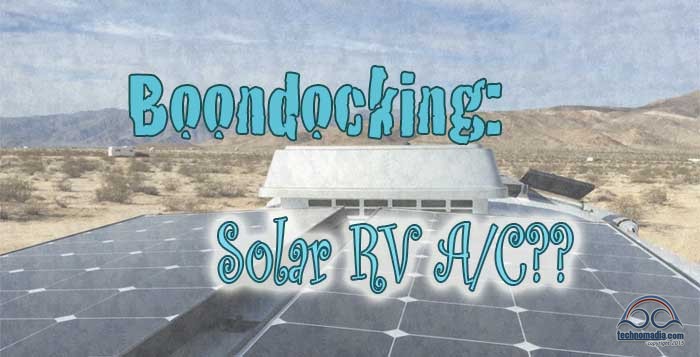
 We see the questions all the time – people wondering: What will it take to run an RV air conditioner off of solar power?
We see the questions all the time – people wondering: What will it take to run an RV air conditioner off of solar power?
We get asked for advice in email regularly, and see the topic constantly coming up on various forums. (And now the Wynn’s are claiming they’re doing it – they’re not really, see below.)
Usually those asking are honestly naive about what will be required – assuming that a small investment in a few hundred watts of solar panels and maybe an extra battery or two is all that it will take to be basking in off-grid cold air all summer long.
I hate to be a destroyer of dreams, but…
Running an RV air conditioner exclusively off of solar power is a fantasy that is extremely difficult and expensive to turn into a reality.
As anyone who has ever paid a residential electric bill during a hot summer knows, generating cool air takes a lot of energy. Cooling an RV isn’t magically easier or cheaper – and in a lot of ways it is even more challenging.
Especially while trying to rely primarily on solar power.
Just consider a few of the things you’ll have working against you:
- Using roof-mounted solar panels means parking in the sun, and parking in the sun means that your AC has to work substantially harder to keep your interior cool.
- Solar panels absorb heat and get extremely hot while producing energy. Having panels on your roof on a hot summer day is like wrapping your RV in a heating blanket – forcing your AC to work even harder. Thin panels with no airspace underneath them will get hotter still – this is one of the reasons we decided not to go thin and flexible on our roof.
- Solar panels actually produce less energy as they get hotter, so on the hottest days when you need the power the most they are working less efficiently.
- By the way – your roof AC is now surrounded by extremely hot air radiating off the panels, further reducing the cooling it is capable of.

Just a little shade creeping onto the corner of a solar panel can cut its output dramatically. - Also – any shade your vents or roof AC casts on your solar panels will dramatically rob them of energy. A little partial shade on the corner of a panel can cut off the output of the entire panel. Most RV roof airs are not low-profile, and even low-profile AC’s can cast substantial shadows much of the day.
- Adding insult to injury – RV roof AC units are sadly NOT designed to be energy efficient, and are actually anything but – particularly compared to residential AC units. Most RV’s are not very well insulated either. The poor cooling efficiency and lack of insulation means that it takes a lot more power to keep the interior of an RV cool than it would to cool a modern well-insulated house of the same (small) size.
In other words – things are pretty bleak.
Cooling a conventional RV using a solar-powered AC is akin to pushing a boulder up a mountain… while wearing roller skates.
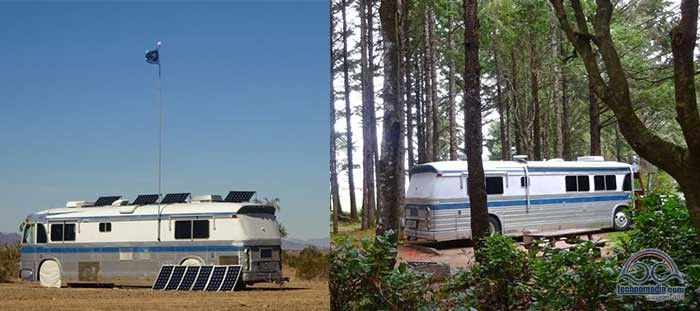
RV AC Power Requirements
Air conditioning units uses a lot of power – likely way more than just about all the other electrical devices you’ll find in an RV combined. The only typical RV appliance that rivals an AC in power consumption is a microwave / convection oven – but those aren’t on for hours at a time.
As an example, from our energy audit, we know that our two roof airs use this much power:
- Coleman Mach 8 15,000 BTU (Front AC): During this particular test, we measured 1,738W (136 DC amps) when on high cool, 1,631W (131A) on low cool, and 99W (7.5A) when the compressor is off but the fan is on. When we purchased this AC in 2013 this was the most power efficient low-profile 15,000 BTU air conditioner on the market, but that’s not necessarily saying a lot.
- Dometic Penguin 13,500 BTU (Rear AC): We measured 1,487W (116A) on high cool, 1,456W (114A) on low cool, and 296W (22.5A) when the compressor is off but the fan is on. This is a vintage 1989 AC unit that came with our bus, and is still running great.
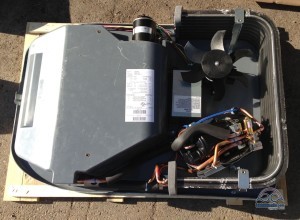
When in use, an air conditioner blower remains on full time but the compressor pump cycles on and off. An AC is actually cooling air when the compressor is on, and just blowing a fan to circulate air when the compressor is off.
The compressor is the big power hog, and whether it is on or not is controlled by the AC’s thermostat. How much time an AC spends with its compressor on will vary dramatically based upon the outside heat and humidity.
The compressor also uses more power when the outside temperature is higher – so on a hot day the actual power consumed will be even higher than you’ll see if you test on a more temperate day.
On a hot summer day the AC compressor might be on non-stop fighting to keep things cool. On a summer night, it might be on 50% or as little as 25% of the time.
Doing a little math, you can work out an energy budget to come up with a range of how much power an AC might need over the course of a day:

- 100% Cooling Cycle: Our front AC would consume roughly 42kWh (kilowatt hours – this is the unit of measurement that electricity is metered and billed in) with 24 hours non-stop high cooling, and our rear AC would consume 35kWh. Fortunately there are few places that are so hot they would keep an AC running full-out 24 hours a day, because that is a ridiculous amount of power. At a common electric company price of 12-cents a kilowatt hour, both AC’s running full-out over the course of a day could cost $9.00 if on metered hookups.
- 50% Cooling Cycle: Cycling the compressor on only half the time, our front AC would consume roughly 22kWh, and our rear AC would consume 21kWh over the course of 24 hours. The front AC’s more efficient blower is starting to really demonstrate a power savings, but this is still a ton of power consumed.
- 25% Cooling Cycle: Cycling the compressor on only 25% of the time, our front AC would consume roughly 12kWh in a day, and our rear AC would consume 14kWh.
Leaving all other electrical loads out of the picture, it is easy to see that you could regularly need to generate over 10kWh a day of energy dedicated to running a single RV roof air conditioning unit – even if you only leave the AC on during the hottest part of the day.
To have even the slightest hope of powering this sort of demand purely via solar – this is what it would take:

- A Ridiculous Amount of Solar Panels: The amount of actual generated power you will get from solar panels will vary dramatically based upon your latitude, the time of year, the weather, and whether or not the panels are tilted optimally toward the sun. A 2,000W system, give or take, is a good start if you want to run an RV roof air for more than just a few hours a day. That’s 20x 100W panels – over 120 square feet of dedicated roof space!
- A (Half) Ton of Battery Capacity: To store 10kWh of power to get through a hot and muggy night will require roughly a 1,000Ah lithium battery bank, or 2,000Ah lead. You are looking at potentially 8x 8D batteries, and over 1,200lbs of lead on board if you go this route, and more if you want excess capacity to get through cloudy days.
- A Hefty Pure-Sine Inverter: An air conditioner should only ever be powered via a pure-sine inverter, and RV AC units have a substantial initial surge current so the inverter needs to be oversized to avoid overloading. To power an AC off of battery or solar power, an expensive high-end inverter capable of 3000W – 4000W output will be necessary, and you’ll still need to shut off the AC when simultaneously using the microwave or other high-current loads.
You could pay for a seeming infinite amount of generator run time, or years of camping with full hookups, for what building a solar system so powerful would cost!
In other words… don’t pursue solar air conditioning with any hopes of it saving you any money in the long run.
The Smarter Way To Stay Cool With Solar
One of the greatest advantages of living in a house with wheels under it is that you do not need to fight the weather – you can move!
Following temperate weather and moving north and south means that it is possible to mostly avoid hot and humid days when an air conditioner feels most necessary.
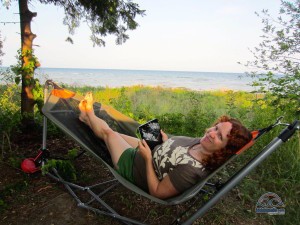
Moving to higher elevations when temperatures start to rise might be the quickest retreat.
Parking in the shade, covering windows with awnings, and using plenty of electric fans makes it often very possible to stay cool without needing to blow the energy budget.
Sleeping through the hottest part of the day and taking an afternoon siesta can work wonders too.
In a dry environment, a full-rig swamp cooler, or even a personal mister, can cool things dramatically without using much energy at all.
And on those few days when you really really really need some proper air conditioning, you have options:
- Field Trip: Spend the afternoon out shopping, or driving, or going some place where someone else is providing the AC. Mall walking is even an option if you get desperate. When we were stuck in Yuma during the summer once, we managed to come up with an excuse for a shopping trip nearly every single afternoon – just to find some cool air!
- A Brief Blast of Solar AC: If you have excess power available (and your inverter is configured to power your AC) an hour or two of AC in the afternoon might not blow the energy budget for the day. But be careful – your batteries will be draining fast! (This is the route we’ve gone with our setup – our 500AH of lithium batteries and 1400w of solar can give us some battery powered off-grid A/C.)
- Generator: Look, we hate the sound of generators… But if you are out boondocking and everyone else within earshot has given in and fired up, your not going to get a special “solar purist” medal for sweating. A few hours of generator time will top off your batteries and cool you down on a hot afternoon.
- Seriously, Just Go Pay For Hookups: If it is 100+ degrees out, stop trying to fight it. Rather than run a generator 24×7 to keep boondocking off the grid, go find a cheap RV park and pay for 50A service. Run all of your roof airs at once and chill out till the heatwave passes!
100% Solar RV AC Can Be Done – If You Design For It
If you really want to go generator-free, have air conditioning whenever you want it, and never pay for hookups… It can be done.
But you will need to design your entire RV around optimizing for this capability.
One of the few examples I have seen is the Over The Top Cargo Trailer – with 2250 watts of solar dedicated to the task of creating a 100% solar heated and cooled a 7′ x 18′ windowless box. It is an awesome project – but it shows just how hard it is to go 100% solar once air conditioning is in the mix.
If you want to go down this path, you will be doing it for the geek points – not because it is practical, or to save money.
As long as you know what you are getting into, here are some tips:

- Swamp Cooling: The cheapest and easiest and most energy efficient way to generate cool air is via evaporative cooling – also know as using a “swamp cooler”. A swamp cooler works by combining warm dry air with water from a tank, producing cool moist output as the moisture evaporates. There are roof mounted and portable swamp coolers you can get for your RV, but they come with a big catch…Swamp coolers only work when the outside humidity is less than 40%, and the dryer it is, the better they work. So a swamp cooler might keep you cool in the desert southwest, but, ironically, it will do nothing but make it feel even steamier if you use one while camped in a swamp.If you’re primarily planning to stick to arid environments, this may be a practical option. If you’re designing for versatility and traveling all over (like us), then this is a lot of space and resources to dedicate to just one climate.
- Ditch The Roof Air: If you want a real AC that can keep you cool on a hot and humid day – you really need to stop pushing a boulder uphill while wearing roller skates. The first step – ditch the boulder – the standard RV roof air.

A mini split air conditioner requires an indoor wall mounted unit connected via cooling hoses with the “outdoor” unit tucked away somewhere well ventilated. The most energy efficient cooling capability comes from a modern inverter compressor two-piece “mini split” air conditioning systems, like this 12000BTU Thermocore. But retrofitting this sort of small residential-style unit into an RV is a major engineering undertaking – you need to find both a place for an interior wall mounted blower unit (or two), as well as a ventilated basement area for the outside unit.
You also need to be able to route the coolant hose between these two locations – often easier said than done in an RV.
We’ve seen some RV’s that have been retrofitted with mini split cooling, and they are extremely quiet and energy efficient in operation. We’ve fantasized about a mini split in our bus, but the overhaul that would be required would be prohibitive. We just don’t have any open wall space!
- Cover The Roof With Solar: With no roof AC’s in the way, you can cover a flat roof from corner to corner with solar panels without worrying about shading – maximizing your harvesting capability, even without tilting.

An external solar array can be deployed tilted towards the sun while you park your rig in the shade. But it is going to take a lot more than the 600 watts here to keep an AC going! - Deploy A Remote Array: Instead of (or in addition to) covering your roof with solar, park in the shade and set up 1000+ watts of ground-deployed panels at the end of a long extension cable. This will require a substantial amount of setup and teardown, but it will let you optimize your rig for shade and your panels for sun.
- Minimize Your Cool Area: A smaller interior is a lot easier to cool. One option is to just cool the office area during the day, and the bedroom at night.
- Insulate Like Crazy: Insulate your walls and roof as much as possible. Desert buses are actually known for having 6+ inches of roof insulation to help keep the interior cool. Eliminate windows, use awnings to keep the sun out of any you do have, and make sure to use double-pane glass too.
- Go Lithium: Lithium batteries are much more efficient at powering high-current loads than lead, so especially if running an AC overnight is your goal, the advantages of lithium become even more convincing. Make sure you design in enough capacity to keep you cool on cloudy days too.
- DC Air, If You Dare: Converting 12V DC (direct current) power from solar panels or batteries into 120V AC (alternating current) to power the AC (that chill making thing) is an inefficient process. There are however a few air conditioners designed to run directly off of DC power, but few of them work efficiently with 12V power.The reason – transmitting that much 12V power over any substantial distance would require power cables the thickness of your wrist running between your batteries and your AC. As voltage goes up, the cable size required to transmit the same amount of power goes down. At around 48V, DC air conditioning starts to be practical.But using a 48V DC AC means designing your entire battery, solar, inverter, and DC electrical system around 48V – a very unusual configuration for RVs, though common in off-grid homes. Here are two examples of 48V DC mini split systems: Green Energy and Hotspot Energy, and even an RV roof top model by Kingtec Solar.
If you go all out optimizing for off-grid mobile AC, you can do it. And if I was tackling an RV bus conversion from scratch, I probably actually would seriously explore a 48V system and DC air.
I love earning geek points, after all.
But the cost and complexity of retrofitting an existing RV for fully solar-powered cooling just doesn’t make a lot of sense. And if you do go all out building enough solar into your rig to keep cool during a hot summer, you’ll actually have power going to waste much of the rest of the year.

Isn’t it smarter to design for the more typical case?
Roller skates and boulders, after all…
Maybe someday the equations will change, especially if some manufacturer were to apply the technology used in mini split AC units to building an RV roof air.
But seeing as how little RV air conditioners have evolved in the past 40 years, I wouldn’t hold my breath…
Our Setup / Compromise
We did want to be able to run our air conditioner off batteries and get a blast of cold air, or keep the RV cool while in a parking lot while running errands.
In 2011 we started with a 3000w hybrid inverter and 500AH of lithium batteries. This allowed us to be able to run one of our A/Cs off batteries for about 2.5-3 hours before completely draining our batteries. This setup got us through a horrible hot summer when our engine broke down, and we lived in a parking lot for 6-weeks with only a 10A power plugin –we could supplement off battery through the heat of the day, and re-charge overnight. The flexibility of not needing 30A or 50A hook-ups has been very freeing, and given us so many more choices for driveway surfing and better views.
While underway, our only air conditioning is our roof A/Cs, and this setup allows us to run off the batteries while re-charging with our heavy duty alternator (that was originally designed to run the bus’ over the road A/C, which was taken out when our bus was converted to a RV.)
In 2014, we added on 800w of solar on our roof (the max we could install while keeping our sweet vintage looks), and 600w as a ground deployed array. On a perfect sun day, with all of the panels perfectly tilted – we would be able to ‘almost’ keep up with one roof A/C for a short bit of time. But perfect rarely happens, and most of the time we’re not collecting anywhere near enough power to keep up with a roof A/C alone.
When we did a major round of bus renovations in the summer of 2015, this setup allowed us to downscale to a 2500w propane generator. Which is plenty to supplement the energy depletion that solar alone just can’t keep up with.
Other related articles:
Solar:
- Our entire Solar for RVs Series
- Solar Planning: Conducting An RV Electrical Consumption Audit
- Being Electrically Abundant in a Mostly Electric RV
- Our 800 Watt RV Bus Roof Solar Install
- Understanding Solar Panel Specifications
Boondocking:
- Our Entire Boondocking Guide Page
- Being Electrically Abundant in a Mostly Electric RV
- Keeping Warm while Chilly Camping
- Extending the Holding Tanks
- Finding Campgrounds & Boondocking Locations
But What about Gone With the Wynns? – They’re Runing Their A/C off Solar!
In February 2016, our friend’s Nikki & Jason put out a video called Off Grid Solar Powered RV Air Conditioning. Their title is a bit misleading – they are NOT running their A/C entirely off solar (which this article is addressing).
Their setup is very similar to ours. We have 500AH of lithium batteries and 1400w of solar and they have 700AH of lithium and 960w of solar.
They, like us, are running their A/C off batteries, and recharging some of that energy with solar when the sun is out.
Our goal wasn’t to run A/C entirely off solar. But we have been running our A/C off batteries for nearly 5 years, and it works GREAT. We think this is a very practical compromise.
But neither of us has enough solar to keep an A/C running without taking power from our stored power in our batteries. We both will run into all of the challenges listed above. During peak sun, we can keep our A/C going about 3 hours before depleting our batteries. The Wynn’s can get probably an hour or so more with their larger battery bank. But at the end of a particularly warm day – we’re both going to end up with depleted batteries that are unlikely to get us through the evening with our respective electric fridges and certainly not repeating another day of A/C without some sort of alternate re-charge (alternator, generator, electrical plug-in, etc.)
Again, this is cool (sometimes literally) and a very practical approach. But it is NOT running an A/C entirely off solar. So please don’t assume that if you copy their or our system you’re going to be running an A/C all day long, day after day, without ever turning on a generator or plugging in.

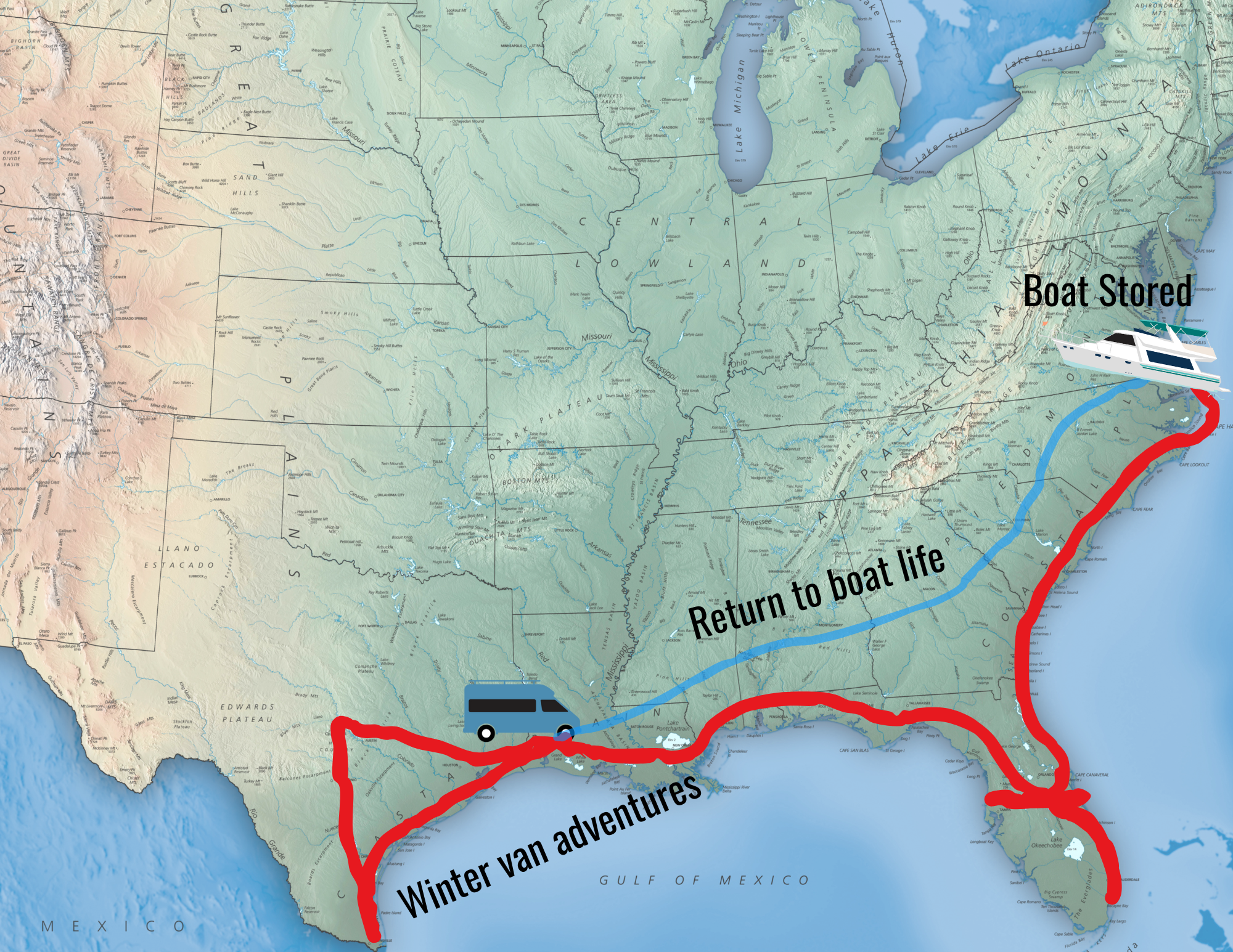
I’ve got daytime-only, off grid air conditioning in my RV. 2100 watts of solar on the roof. Pioneer Mini split mounted in the old generator location. Pulls about 700-800 watts on Eco mode. As much as 1400 watts on turbo mode. Cool air all day and batteries stay at 100%. I just don’t have enough batteries (400ah lithium) to keep it up during the night.
very nice and useful ideas thanks for shared.
Your experiment and another popular RV site seem to be go to articles on this subject. Sorry if what I propose has already been presented.
Both expirements involve large interior space and Alertnating Current Air Conditioners BUT…. How about a smaller Interior space (Van. Truck Camper, Small Class B, C) using a Direct Current more efficient Air Conditioner along with a Solar, Batteries, Maybe wind generator and maybe on demand generator to fill the gaps at times.
I’m one of those weird Prius Campers (04 Prius) that uses a very efficiant DC AC, Hybrid Battery which the Engine recharges the battery quietly. Usually park in the best shade I can get with good air flow or even wind, set fan speed about medium or slighty less and temp 75 F closed circulation and dress to keep cool (shoes, socks off in summer). I’ve done this all day everyday in temps over 100 F with High humidity (Coastal Carolina). I have a lot of room with both seats forward, appx 8 feet bed, Fridge. Another seat behind drivers with lots of leg room where I can cook, sponge bath, work on laptop and even emergency bathroom. Fine for an ultraminimalist like me and a chihuahua that loves it (she growls when I take her out). I also use tint that blocks heat and may use reflective outside cover but I always park in shade although temperate climates and window socks is ideal. Longest non-stop in hot weather was after hurricane with no eletric 48 hours and the car sips gas.
I am researching now a system for that is affordable to do this with. So far I’ve seen expensive systems. RV ones usually overseas. 18 wheelers and marine. I have an inverter but try to avoid it’s use and find all DC powered items with efficient consumption although water heating is slower. I know your intent was dealing with the question in more common RV setups that have AC AC’s. Wonder why they don’t more RV’s with DC AC’s…. Maybe designed for RV hookups. I know some RV parks are better than others with more space but really like the boon docking away from neighbors.
This may not be an issue in years to come with battery and solar technology constantly advancing.
Take a look at what Winnebago is doing with some of their lithium powered Class-Bs – some interesting stuff there. But that’s not running an AC off solar alone – which is what this article is about
They make DC volt air conditioners intended for off grid/non-idling usage. Been researching for my upcoming project RV (military M934). It’s got enough roof for about 12 Panasonic 330watt panels (roughly 2-4kw total), plus about 320 amp hour of reserve of planned truck batteries, and plans for about 1k watt battery bank. The truck is a 24v system, and will wire the solar in as the same (so truck can charge it as well, while the charger can maintain batteries, and already did this to a 89 club wagon with 400 watt system w/ 320ah battery bank). Research/price hunting is a nightmare for off grid due to most places forcing you to call them I mean seriously what’s the point in a website or I’m forced to call for price lol.
Thank you guys so much for this article! I’m one of those naive newbies who has been trying to find someone to explain the whole, “how do I run an A/C in an RV” thing in easy-to-understand language. Now I get it!